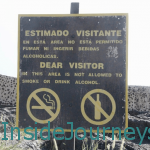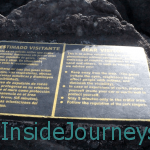Windmills seemed to sprout out of the Nicaraguan countryside, their blades turning lazily as we moved quickly from the border of Costa Rica towards the historic town of Granada. Seeing them made me smile and I pulled out my camera to capture a few shots as we passed but the tops of familiar-looking trees kept getting in the way.

I don’t now remember which I saw first – the water or the volcano. Each added a new and exciting dimension to the view. I was sure we were looking at the Pacific Ocean but Eric, our tour guide, said it was Lake Nicaragua, the largest lake in the country. It seemed to follow us for miles.
Since I hadn’t done my homework on Nicaragua, I was surprised to learn that the country has 19 volcanoes. Mombacho, the volcano that had come into view, is dormant, erupting last in 1570. At about 4,500 feet, with its classic cone, it towers over Lake Nicaragua and Granada. Though we didn’t visit Mombacho, Eric said it has a nature preserve with endemic flora and fauna, a cloud forest, and at least two hiking trails.
Unlike Mombacho, which hasn’t erupted in centuries, Masaya continues to send plumes of sulfur into the atmosphere. Located in the Masaya Volcano National Park, Masaya is a drive-up volcano – the only one, Eric said, proudly, in the Western Hemisphere.
On the way up, he pointed to the black, lumpy moist-looking soil near the volcano and the lush vegetation around. He also showed us a fragile and lonely-looking wooden cross atop Masaya.

Believing that the gods’ unhappiness with them caused the volcano to erupt, the indigenous people sacrificed young women and children to appease them and quiet the mountain. In the 16th century, a Spanish priest (the Spanish called Masaya El Boca del Infierno, the Mouth of Hell) no doubt outraged by this ritual, felt a cross (La Cruz de Bobadilla – Cross of Bobadilla) near the crater would stop the eruptions. Eric didn’t say how many times the cross has been replaced.
As the bus groaned to a stop near Masaya’s crater and the driver opened the door, the acrid smell of sulfur hit us square in the face. Because of this, Eric said we could spend only 15 minutes. (Looking at my photos now, one sign said 5 minutes.)
To my surprise, several cars were parked near the rim of the volcano and people were walking around casually, like they were out for a Sunday stroll. I recognized a family I had seen in the craft market we had visited earlier, and there was a group wearing what looked like traditional dress performing as a photographer took their photos. It was all so matter of fact.





Masaya is not only a drive-up volcano you can walk right up to the low wall near the crater. There are signs warning visitors not to smoke or drink alcohol – the volcano is constantly belching gas making it difficult to see much inside. But it was weirdly cool to be so close to an active volcano.
While it’s dangerous for us, Masaya has a hardy lot of parrots that thrive on its noxious gases. We could definitely hear them and did see a few as they flew out.
Asked if there had been any deaths at Masaya, Eric told us of a man who jumped to his death in 2010. Not surprisingly, his body was never recovered.

Our next stop was the Apoyo Lagoon, the largest of three volcanic lagoons in Nicaragua – the surprise Eric had been hinting at as we were leaving Masaya. We ooohed, aaahed and clapped when we saw it, framed by the red and yellow rays of the setting sun – the perfect end to a full day of activities.
Apoyo has over 500 species of plants and trees, including black rosewood and mahogany, Capucin monkeys, anteaters and other animals, and more than 200 species of birds. It’s also a popular water sports destination.
There is a large craft market as well as a restaurant and, on one side of the lagoon, several benches for people to sit and enjoy the view.


Apoyo was our last stop in Nicaragua. We had covered a lot of territory in one day. I was tired but elated, pleased with my decision to take the one-day tour, which, back in August cost US$160.
The tour included the colonial city of Granada, a boat tour Lake Nicaragua’s Monkey Island, shopping at the craft market, Masaya Volcano National Park, Apoyo Lagoon, and lunch. I made arrangements for this tour with Claudia at LEP Costa Rica – 506-8377 5701 or concierge@lepcostarica.com

As we took our seats on the bus for the journey back to Guanacaste, Eric announced that he had one more surprise. He stuck his hand into a large, black plastic bag and called my name. To my surprise, he handed me a maracas with my name engraved in it. No, I wasn’t singled out for special treatment. Everyone received one too. While we were touring Granada, a carver had been busy creating these personalized mementos for each of us. It was a lovely treat, a beautiful reminder of Granada, Eric and the tour.













Sounds as if you had quite the adventure-packed day! Your last photo reminds me of Crater Lake in southern Oregon.
It was, Patti. Usually, I pass on tours but I’m really glad I did this one – it was a great intro to Granada.
BTW, I looked up Crater Lake and it does look like Apoyo.
The views of the volcano are breathtaking!
I didn’t know that Nicaragua had active volcanoes!
19 volcanoes! and so mysterious-looking. Fascinating post, Marcia.
These photos are truly impressive! I especially love that dark one of the volcano with the cross, it’s really mysterious 🙂
That’s amazing that you can just drive by there and be so close to an active volcano! Here in the Philippines, the volcanoes are usually only accessible by hiking. And you got performers there too??? LOL
A very interesting introduction to Nicaragua’s natural wonders, Marcia, and obviously a very satisfying day for you.
Great post! You had fun in your trip and you did very well on capturing the volcanoes. Thanks for sharing the pictures of these volcanoes. I hope someday I can visit here.
Great photos…
It’s an eerie feeling standing next to a volcano. It makes you feel fairly powerless next to something that can be so explosive and… well… powerful. We’ve never been to this one, but did get close to a few in Costa Rica.
Wow! Spectacular shots and an equally captivating narrative! All that smoke is so so intriguing!
I had no idea there were any volcanos in Nicaragua! So, an awesome learning lesson tonight! I know that smell of sulfur and it is the worst in world…that an freshly laid asphalt lol 🙂 Your pictures are stunning, Marcia. I like the one of you leaning against the wall at the edge and the Apoyo Lagoon ones the best 🙂